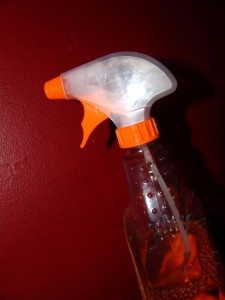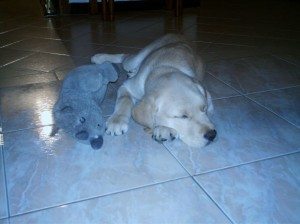I used to love Swifters! After-all they are fast and for those quick jobs…..what could be better? I even love the commercials when the dirt gets picked up so easily and I can count the time I save. But at one point I realized that my housecleaning was NOT green and could actually be dirtying my household environment and harming our pets ?
It was 2004 when that rumor about the Swifter WetJet circulated rapidly among pet owners alleging that they contained antifreeze and this was harmful to pets. The ASPCA quickly investigated and The Wet cloths and declared that the cleaners did not contain antifreeze or any harmful chemicals and were in fact, safe to use around pets . I felt better but my mind was still not at ease and I decided that I really needed to start thinking about the products I used and to ensure that I did not use products that contained harmful ingredients. My mission began shortly after the whole Swifter controversy.
I came to realize that probably the best idea would be for me to make my own because though they might not bear a warning label, many household cleansers contain harmful ingredients that could potentially pose problems. Try a simple test…look at the back of many your conventional detergents, solvents, and polishes. Check to see if they contain paraffin, mineral oil, diethylene glycol, perchloroethylene, or butyl cellosolve—all of these derived from petroleum and contribute to air and water pollution. Lets look at their uses and
Phosphates/EDTA: softens water and increases cleaning power / encourages algae growth, limits oxygen and degrades very slowly.
Phthalates: prolongs scent / linked to cancer and disease of the reproductive system in laboratory animals.
Antibacterial agents: creates antibiotic-resistant bacteria / decreases immune system strength /efficiency
Chlorine bleach: whitens/disinfects / forms chlorine-carbon compounds that damage the Earth’s ozone layer.
Doesn’t really sound that great right? To find out more about what’s REALLY in your cupboards, check out the National Library of Medicine. They go over products, manufacturers, ingredients, and health effects from everything from your cleaning supplies to your personal care products as well as pet care supplies and what you use in your home and office.
Anyway, it has been awhile that I think “GREEN” when it comes to my environment. There are always alternatives. There are so many common products that are “environmentally friendly”, cheaper, and often have that “multitask” feature.Thet are even mor effective because they organically break things down while neutralizing odors.
- Citrus/Plant-based oils are degreasers (orange, lemon), disinfectants (tea tree, eucalyptus), polishes (olive) and air fresheners all in one.
- Soda naturally softens water and great for scouring
- Natural drain openers uses digesting bacteria and enzymes to eat through clogs.
- Non-chlorine bleach use oxygen to whiten and brighten clothes.
- Vinegar naturally cleans, disinfects while killing bacteria, mold, and viruses.
Here are some other helpful tips:
1. Soak up dog urine, rinse the area with club soda, and blot up.
2. The acid in dog vomit stains fast, scoop up as much as you can, coat the area with baking soda or salt, let it dry, then vacuum. Pour club soda on the area and blot.
3. If your animal has favorite sleeping spots, place an easy-to-wash soft towel to absorb skin odors and catch the fur.
4. For flea control- salt your carpets when winter ends (before flea season). Let the salt stay on 10 minutes then vacuum up. Or.. sprinkle dried, crumbled peppermint and vacuum
5. For general pet odor problems, try an inexpensive method- mix baking soda in water and saturate the area. Let stand a few minutes, blot, and air dry.
6. Hydrogen peroxide is an excellent method to remove blood stains. Simply apply some to the blood-stained area and let it bubble. Repeat this until stain is gone. Follow up by dabbing the area with water and dry. Milk also works-Pour some milk over the blood stain to loosen the blood and blot.
7. Standard white vinegar mixed half and half with water gives you a great, inexpensive, multi-purpose, nontoxic deodorizer and cleaner.
8. A dab of toothpaste gets out some stains on fabric.
Take some time TODAY to check out what is in your cupboards. Do you have Pine Sol, Mr. Clean, Clorox Bathroom Cleaner, Scrubbing Bubbles, Clorox Automatic Toilet Bowl Cleaner, Mr. Clean Multi-Purpose Spray, Draino, Liquid Plumber, Windex, Tide and/or Cheer? These are just a few of the products that are very popular but do contain harmful chemicals/toxins. In fact several studies concluded that 3 very popular and widely- used cleaners, Pledge, Clorox Wipes and Lysol Disinfecting Spray, registered close to a “thousand times more vapor pressure than a natural cleaner”. Think about it-this means that even after these cleaners are closed up and put away, the vapors continue to circulate.
So..it turned out that in fact it was all a MYTH about Swifter Wet-Jet but it is true that there are a lot of products out there that are harmful to people, pets and the environment in general. If your household is anythinglike mine, your dogs and cats hang out, snooze, play and eat treats off the floor. Animals in general have faster metabolisms, smaller lungs, and weaker immune systems than we do. Think about the fumes that often linger and bother us..well pets have to work harder to process chemicals as well as eliminate toxins. Our pets spend a majority time close to the ground and thus more vulnerable to the substances we use.
So, let’s all be aware, and do our best to create a healthy and toxic-free environment for our pets (and people)..after-all we are ALL WORTH IT!
 Montreal Dog Blog Montreal's Online Dog Park
Montreal Dog Blog Montreal's Online Dog Park





